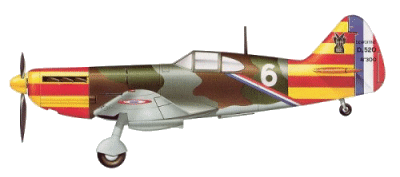The Dewoitine D.520
was slower than the Messerschmitt Bf.109E but clearly superior in
manoeuvrability. A comparison was made on April 21, 1940, with an
intact Bf.109E-3 that had been brought down in French territory. This
comparison highlighted the fine qualities of the best French fighter
of World War 11. Had France not surrendered in June 1940, the
Dewoitine D.520's career might have been comparable to that of British
and German fighters. Of the 775 D.520s built during the war, only 36
were on front-line duty on May 10, 1940, too few to have a significant
effect.
The D.520 was born in
1936. It was a private undertaking of the famous French airplane
builder Emile Dewoitine. But the military authorities did not
officially accept the project until April 3, 1938. The French
government had already ordered Morane Saulnier M.S.405s, and the
development of still another fighter aircraft did not seem sensible.
The first Dewoitine D.520 prototype took to the air on October 2,
1938, but it did not make a favourable impression. Because of the
arrangement of the radiators, the engine overheated, and the plane
failed to reach its expected speed of about 325 m.p.h. So the aircraft
was altered. The radiators were moved from the wings to the belly of
the aircraft, and the exhausts were redesigned, thus overcoming the
main difficulties. A second prototype was built, and its rudder,
cockpit, and landing gear were subsequently modified. During official
test flights, this plane reached speeds up to 340 m.p.h. at 17,000
feet altitude. The plane reached a height of over 26,000 feet in 12
minutes and 53 seconds. When preliminary testing ended, in April 1939,
a first order for 200 aircraft was placed, with delivery set between
September and December. A second order was placed in June, for 510
planes. By April 1940, orders for the D.520 amounted to 2,320
aircraft, to be delivered at a rate of 350 per month.

5th Escadrille Groupe de Chasse III/6 Armee de l'Air de l'Armistice,
Algeria 1941
Production was very
slow because of difficulties in tuning the engine and putting
finishing touches on the armament system. By January 1940, only 13
planes had come off the assembly line. Only in April, when the 139th
aircraft was delivered, could the Dewoitine D.520 be considered fully
operational. By June 25, when the armistice was signed, a total of 437
planes had been built. The Germans resumed production in the summer of
1941 and continued until December 1942. The Dewoitine D.520 was used
by the Luftwaffe, Regia Aeronautica (60 aircraft in 1942-43), Bulgaria
(120 aircraft from 1943), and Romania, as well as by Free French units
when the Allies invaded Europe.
After the war a few
dozen D.520s were equipped with double controls and used as training
aircraft. The last D.520 fighters remained in service until September
1953, in a special non-combat unit, the Escadrille de Presentation of
the Armee de l'Air.
Specifications (Dewoitine
D.520)
Type: Single
Seat Fighter
Design:
Dewoitine
Manufacturer:
SNCA du Midi
Powerplant: One
935 hp (698 kw) Hispano-Suiza 12Y 45 12-cylinder inline, liquid
cooled, piston engine.
Performance:
Maximum speed 332 mph (535 km/h) at 18,100 ft (5500 m); service
ceiling 34,540 ft (10500 m).
Range: 552
miles (890 km) with internal fuel stores.
Weight: Empty
4,490 lbs (2036 kg) with a maximum take-off weight of 6,160 lbs (2790
kg).
Dimensions:
Span 33 ft 6 in (10.20 m); length 28 ft 9 in (8.76 m); height 8 ft 5
in (2.57 m); wing area 171.84 sq ft (15.97 sq m).
Armament: One
20 mm Hispano-Suiza 404 cannon firing through the propeller hub, plus
four 7.5 mm (0.295 in) MAC 34 M39 machine guns.
Variants: D.520
(prototype and production), D.521 (a single D.520 with a 1,030 hp (768
kw) Rolls Royce Merlin engine but this proved unsatisfactory), D.524
(the single D.521 with a 1,200 hp (895 kw) Hispano-Suiza 12Z engine),
D.530 (planned upgrade using a 1,400 hp (1045 kw) Rolls-Royce or a
1,800 hp (1342 kw) Hispano-Suiza 12Y engine, but it was never built),
D.550 (racing version of the D.520 with a more powerful engine and
shorter wings), D.551/D.552 (military versions of the D.550 powered by
the 12Y 51 or 12Z engines, respectively. Neither were never built due
to the German occupation).
Operators:
France, Luftwaffe, Regia Aeronautica, Bulgaria, Rumania, Free French
Forces.
